Posts
Sitali Breath Pranayama
As a seasoned fitness trainer with over two decades of experience, I've dedicated my career to blending holistic practices with traditional fitness training. At VillaSport, where I conduct weekly yoga classes, the interplay of suggestions from attendees significantly shapes our practice. Embracing a recent proposal, we've decided to delve deep into a specific Yogic breathing technique each month. This time, we're exploring the transformative world of Sitali Breath, or Cooling Breath.
Journey into Yogic Breathing
My voyage into Yogic breathing was driven by the pursuit of enhancing performance through natural, intrinsic methods. This exploration unveiled the serene and focusing power of various Yogic breaths, now an integral element of my Sound Bath and Restorative Yoga classes at VillaSport in Beaverton. These practices are pathways to profound physical and mental well-being.

More about Sitali Breath
Sitali Breath, or Cooling Breath, is a Yogic technique designed to reduce body temperature and soothe the mind. Known for its cooling and calming effects, Sitali Breath is particularly beneficial for managing stress, anxiety, and heat-related discomforts, making it a vital practice for overall wellness.
A Step-by-Step Guide to Practice
- Begin by finding a serene and comfortable setting for your practice.
- Sit in a comfortable position. Form an "O" shape with your mouth and curl your tongue lengthwise. Inhale deeply through your curled tongue as if sipping air through a straw. Close your mouth and exhale slowly through your nose. Repeat this process several times.
- Consistent practice is key. Dedicate several minutes each day to this technique to experience its full benefits.
Your Personal Invitation
I warmly invite you to embark on this journey of self-discovery and transformation through Sitali Breath. It's an opportunity to elevate your mental and physical health. For those eager to deepen their understanding of breathwork, I recommend "Breath" by James Nestor and "The Oxygen Advantage" by Patrick McKeown. Both offer insightful explorations into the science of breathing.
Join our VillaSport community this month to experience the myriad benefits of Sitali Breath. Stay engaged for future insights into the enriching world of Yogic breathing practices.
Kapalabhati Pranayama: The Skull Shining Breath
Kapalabhati Pranayama: The Skull Shining Breath
Kapalabhati Pranayama, often called "Skull Shining Breath," is a dynamic yogic breathing practice deeply rooted in ancient yoga traditions. This technique goes beyond simple breath control; it is a fundamental aspect of yoga that deepens the connection among the mind, body, and spirit. The distinctive aspect of Kapalabhati Pranayama is the forceful exhalations and passive inhalations, which contribute to its energizing effects.
As a fitness trainer with over 25 years of experience, I am deeply committed to integrating holistic practices into my training sessions. At VillaSport, where I lead weekly yoga classes, I greatly value the feedback and suggestions from my attendees. At the beginning of 2024, one participant suggested dedicating each month to a specific Yogic breathing technique. We embraced this idea and selected a particular technique for each month. For May, we are focusing on Kapalabhati. This article aims to guide my class attendees and anyone interested in embarking on this transformative journey.

My Exploration of Breath
My foray into Yogic breathing began with the goal of naturally enhancing performance without external aids. This journey led me to various Yogic breathing methods' calming and mind-quieting effects. This practice is a cornerstone of my Sound Bath and Restorative Yoga classes at VillaSport in Beaverton, offering physical and mental benefits.
Understanding Kapalabhati Pranayama
The term "Kapalabhati" is derived from two Sanskrit words: 'kapala' meaning 'skull,' and 'bhati' meaning 'shining' or 'illuminating.' Hence, Kapalabhati Pranayama, also known as "Skull Shining Breath," symbolizes the practitioner's ability to brighten and clear the mind.
The Technique:
- Preparation: Begin comfortably seated, ensuring your spine is straight and shoulders relaxed.
- Inhalation: Inhale passively through your nose, preparing for the exhalation.
- Exhalation: Exhale forcefully through the nose by contracting the abdominal muscles quickly.
- Rhythm: Continue this pattern, focusing on the exhale while allowing the inhale to occur naturally, synchronizing the breath with the pumping action of your abdomen.
Benefits:
Enhanced Detoxification: The rapid exhalations help expel stale air and toxins from the lungs, promoting better oxygen exchange.
Increased Energy Levels: The energizing effect of rapid breathing can help invigorate the mind and body.
Improved Respiratory Function: Regular practice can strengthen the respiratory muscles and increase lung capacity.
Mental Clarity: The focus required for Kapalabhati can help clear the mind and reduce mental clutter, promoting a state of mental tranquility.
Practice Tips:
Start Slowly: If you're new to Kapalabhati Pranayama, begin with a few cycles, gradually increasing the duration and intensity as you become more accustomed to the technique.
Mindful Practice: Pay attention to the rhythm of your breath and the movement of your abdomen to ensure the practice is done correctly and effectively.
Conclusion
Kapalabhati Pranayama is more than just a breathing technique; it's a pathway to a more energized and clear state of being. Incorporating this "Skull Shining Breath" into your daily routine can unlock numerous physical and mental benefits, enhancing your overall well-being and yoga practice. Embrace the powerful exhalations, and let them guide you to a place of enhanced vitality and mental clarity.
Your Invitation to Join
I warmly invite you to explore the benefits of Skull Shining Breath. Seize this opportunity to transform your wellness routine, and feel free to share your experiences with our community. For those interested in a deeper understanding of the science of breathing, I recommend "Breath" by James Nestor and "The Oxygen Advantage" by Patrick McKeown. These books provide an accessible yet thorough examination of the profound impact of breathwork.
Join our community for the upcoming month of Kapalabhati Pranayama, and stay tuned for future articles offering more insights into Yogic breathing techniques.
Learn to Paddle Board THIS YEAR!
Hi, I'm Tahirih Fields, a certified personal trainer and yoga teacher with over 25 years of experience in fitness coaching. I've designed this paddleboarding program to help you elevate your fitness in a unique and exciting way.
Our Program Includes Three Progressive Stages:
- Condition Your Body: Begin with personalized fitness sessions designed for strength, balance, and endurance, preparing your body for the challenges of paddleboarding.
- Practice in a Private Pool: Build confidence and master the basics of paddleboarding in the safe and controlled environment of a private pool.
- Adventure on the River: Put your new skills to the test with an exhilarating session on the river.
Personalized Attention: One-on-one sessions ensure you progress at your own pace.
Enjoy the beauty of local waterways and natural scenery.
*** Prerequisite: Swimming Proficiency ***

Quick Start Package
Two Sessions
- 1:1 Practice in a private pool
- River/Lake Adventure
$299 per person - Couple rates available
Premium Package
Ten Sessions
- Eight Personal Training Conditioning and Strength-building sessions
- 1:1 Practice in a private pool
- Guided River Adventure
$999 per person - Couple rates available

Exploring Alternate Nostril Breathing
As a fitness trainer with over two decades of experience, I've dedicated my career to blending holistic practices with traditional fitness training. At VillaSport, where I conduct weekly yoga classes, the interplay of attendees' suggestions significantly shapes our practice. Embracing a recent proposal, we've decided to delve deep into a specific Yogic breathing technique each month. This time, we're exploring the transformative world of Alternate Nostril Breathing or Nadi Shodhana Pranayama.
Journey into Yogic Breathing
Driven by my pursuit of enhancing performance through natural and intrinsic methods, I ventured into Yogic breathing. This exploration unveiled the serene and focusing power of various Yogic breaths, now an integral element of my Sound Bath and Restorative Yoga classes at VillaSport in Beaverton. These practices are not just exercises but pathways to profound physical and mental well-being.

Demystifying Nadi Shodhana Pranayama
Nadi Shodhana, or Alternate Nostril Breathing, is more than just a breathing exercise; it's a mental and bodily equilibrium method. Renowned for its stress-reducing, concentration-boosting, and respiratory-enhancing benefits, this technique is a pivotal element of holistic wellness.
A Step-by-Step Guide to Practice
Begin by finding a serene and comfortable setting for your practice.
Position yourself comfortably and use your fingers to close and open each nostril alternately. Inhale through one nostril, seal it, then exhale through the other, and repeat. This alternating pattern is the essence of Nadi Shodhana.
Consistent practice is the key. Dedicate several minutes each day to this technique to experience its full benefits.
Client Story: A Real-Life Transformation
A testament to Nadi Shodhana's effectiveness comes from a client who struggled with snoring and mouth breathing. She witnessed a significant improvement in her nighttime breathing through regular practice, showcasing the technique's impact on enhancing nasal clarity and sleep quality.
Your Invitation
I warmly invite you to embark on this journey of self-discovery and transformation through Nadi Shodhana Pranayama. It's an opportunity to elevate your mental and physical health. For those eager to deepen their understanding of breathwork, I recommend "Breath" by James Nestor and "The Oxygen Advantage" by Patrick McKeown. Both offer insightful explorations into the science of breathing.
Join our VillaSport community this month to experience the myriad benefits of Nadi Shodhana Pranayama. Stay engaged for future insights into the enriching world of Yogic breathing practices.
Exploring Ujjayi Breathing: The Ocean Breath
As a fitness trainer with over 25 years of experience, I am deeply committed to integrating holistic practices into my training sessions. At VillaSport, where I lead weekly yoga classes, I greatly value the feedback and suggestions from my attendees. At the beginning of 2024, one participant suggested dedicating each month to a specific Yogic breathing technique. We embraced this idea and selected a particular technique for each month. For March, we are focusing on Ujjayi breath. This article is designed to guide my class attendees and anyone interested in embarking on this transformative journey.
My Personal Exploration of Breath
My foray into Yogic breathing began with the goal of naturally enhancing performance without external aids. This journey led me to various Yogic breathing methods' calming and mind-quieting effects. This practice is a cornerstone of my Sound Bath and Restorative Yoga classes at VillaSport in Beaverton, offering physical and mental benefits.

Ujjayi Breathing: The Ocean Breath
Ujjayi Breathing, often termed "ocean breath," is a transformative breathing technique deeply rooted in yoga. This method is not merely about breath control but is an integral part of yoga that enhances the connection between the mind, body, and spirit. The unique aspect of Ujjayi Breathing is the slight constriction of the back of the throat during inhalation and exhalation, producing a distinct, soothing sound reminiscent of ocean waves.
Understanding Ujjayi Breathing
The term "Ujjayi" originates from the Sanskrit language, where "Uj" means "to conquer" or "to be victorious," and "jayi" translates to "breath." Hence, Ujjayi Breathing is also known as "victorious breath," symbolizing the practitioner's triumph over the constant fluctuations of the mind.
The Technique:
Preparation: Begin comfortably seated, ensuring your spine is straight and shoulders relaxed.
Inhalation: Inhale deeply through your nose, slightly constricting the back of your throat, to create a soft hissing sound.
Exhalation: Exhale slowly through the nose, maintaining the constriction at the back of the throat to enhance the oceanic sound.
Rhythm: Continue this pattern, synchronizing the breath with the movement in your yoga practice or maintaining a steady rhythm in a seated position.
Benefits:
Enhanced Focus: The audible nature of Ujjayi Breathing helps anchor the mind, reducing distractions and deepening concentration.
Regulated Body Temperature: The friction of air passing through the throat generates internal heat, which can help warm the body during yoga.
Improved Respiratory Function: Regular practice of Ujjayi can strengthen the respiratory system, enhancing lung capacity and oxygenation of the blood.
Mental Tranquility: The rhythmic sound of the breath can induce a meditative state, promoting mental calmness and stress reduction.
Practice Tips:
Start Slowly: If you're new to Ujjayi Breathing, begin with a few minutes daily, gradually increasing the duration as you become more comfortable with the technique.
Mindful Practice: Stay aware of the sound and rhythm of your breath, ensuring it remains steady and soothing.
Conclusion
Ujjayi Breathing is more than just a breathing technique; it's a pathway to a more mindful, focused, and balanced state of being. Incorporating this "ocean breath" into your daily routine can unlock numerous physical and mental benefits, enhancing your overall well-being and yoga practice. Embrace your breath's gentle, rhythmic sounds, and let it guide you to a place of inner peace and vitality.
Your Invitation to Join
I warmly invite you to explore the benefits of Ocean Breath. Seize this opportunity to transform your wellness routine, and feel free to share your experiences with our community. For those interested in a deeper understanding of the science of breathing, I recommend "Breath" by James Nestor and "The Oxygen Advantage" by Patrick McKeown. These books provide an accessible yet thorough examination of the profound impact of breathwork.
Join our community for the upcoming month of Ujjayi Breathing, and stay tuned for more insights into Yogic breathing techniques in future articles.
Exploring Sama Vritti Pranayama (Square Breath)
As a fitness trainer with over 25 years of experience, I am deeply committed to incorporating holistic practices into my training sessions. At VillaSport, where I lead weekly yoga classes, I highly value the feedback and suggestions from my attendees. Recently, one participant suggested focusing monthly on a specific Yogic breath. We welcomed this idea and delved into the practice of Sama Vritti Pranayama, commonly known as Square Breathing. This article will guide my class attendees and anyone interested in embarking on this transformative journey.
My Personal Exploration of Breath
My foray into Yogic breathing began with the goal of naturally enhancing performance without external aids. This journey led me to various Yogic breathing methods' calming and mind-quieting effects. This practice is a cornerstone of my Sound Bath and Restorative Yoga classes at VillaSport in Beaverton, offering a blend of physical and mental benefits.
Understanding Sama Vritti Pranayama
Sama Vritti Pranayama, meaning 'balanced breath,' involves a symmetrical breathing cycle that fosters equilibrium in both body and mind. Research supports its effectiveness in reducing stress and improving respiratory functions, making it an invaluable tool for overall well-being.

Step-by-Step Practice Guide
Create a Calm Environment: Select a tranquil space for your practice.
Breathing Technique: Inhale and exhale through the nose in a balanced pattern - inhale, hold, exhale, pause - each phase lasting four counts.
Consistency is Key: Regularly practice this cycle for several minutes each day.
Client Anecdote: Real-Life Impact
A longstanding client who previously suffered from anxiety attacks experienced significant relief through Square Breathing. She now employs this technique as a direct response to anxiety, showcasing its potent role in stress management.
Your Invitation to Join
I warmly invite you to explore the benefits of Sama Vritti Pranayama. Seize this opportunity to transform your wellness routine, and feel free to share your experiences with our community. For those interested in a deeper understanding of the science of breathing, I recommend "Breath" by James Nestor and "The Oxygen Advantage" by Patrick McKeown. These books provide an accessible yet thorough examination of the profound impact of breathwork.
Join our community for the upcoming month of Square Breathing, and stay tuned for more insights into Yogic breathing techniques in future articles.
The Power of Nasal Breathing in Yoga and Fitness
In the world of fitness and athletics, there's an often-overlooked yet crucial detail: our breathing technique. Recently, a former Yoga class attendee asked me a straightforward but essential question: "Why should we breathe through our noses during Yoga?" He had forgotten the reasoning we discussed in class, and his query reminded me that it might be helpful to share this knowledge more widely. So, I'm writing this piece as a reminder for anyone who might need it, offering insight into the significance of nasal breathing in both Yoga and general fitness.
With over 25 years of experience in personal training, my commitment to helping athletes achieve their peak potential has always driven me to explore methods that enhance performance without external aids like sports drinks or energy gels. My background in Yoga has been instrumental in understanding the profound impact of mastering our breath, which can shift us from a fight-or-flight state to a more relaxed and thriving mode.
The concepts of "survive" and "thrive" are particularly fascinating. They encapsulate our body's response to physical exertion, governed significantly by the rhythm of our breath and its influence on our brain.
In my Yoga classes, the first lesson I teach involves understanding three key reasons to breathe through the nose:
- Nitric Oxide Boost: Nasal exhalation stimulates nitric oxide production, a natural relaxant that soothes our airways and promotes relaxation.
- Efficient Breathing: Nasal breathing allows for slower exhalation, enabling efficient oxygen and carbon dioxide exchange in our bodies.
- Deeper Relaxation: Prolonged exhales lead to deeper relaxation, benefiting both mind and body.
Supporting these benefits, scientific studies offer compelling evidence. A 2018 study in the 'Journal of Physical Therapy Science' showed that nasal breathing increases blood carbon dioxide saturation, improving oxygen uptake. Additionally, a 2020 article in the 'International Journal of Yoga' demonstrated that nasal breathing in Yoga significantly reduces stress by activating the parasympathetic nervous system.
But what truly elevates a Yoga class is the seamless connection between breath and movement. I encourage students to inhale during one part of a movement and exhale through the nose during another, each at their own comfortable pace. This approach fosters a deeply personalized experience, unlike synchronized Yoga classes where everyone moves in unison. I also suggest taking this mindful breathing practice beyond the Yoga mat and applying it to various gym exercises, with a few exceptions.

Nasal breathing's principles are transformative across fitness disciplines. In strength training, syncing breath with movement phases enhances power and stability. During cardiovascular exercises like running or cycling, it promotes a calm, focused state, boosting endurance. In HIIT, controlled nasal exhales during rest periods can quicken recovery. Adopting these techniques across exercise forms not only improves physical performance but also fosters a holistic approach to health.
Many clients have reported significant improvements in breathing, enhanced performance, better sleep, and reduced snoring, all thanks to conscious breath control.
For a deeper dive, I recommend "Breath" by James Nesbitt and "The Oxygen Advantage" by Patrick McEwen. These books offer valuable insights into optimizing breath for better performance.
In conclusion, peak performance begins with something as simple as your breath. Inhale deeply, exhale slowly, and let the natural rhythm of your breath unlock your true potential in fitness and well-being.
I'm eager to hear how breathing techniques have influenced your fitness journey. Have you integrated nasal breathing into your workouts? What changes have you observed? Share your experiences in the comments, or contact me for personalized advice on incorporating these techniques into your routine.

Yoga Retreat & Inward Reflection, Pacific City - Oregon
Join me for 3 days to Relax, Rejuvenate and Unwind
When: 10-25-2020 to 10-28-2020
Sample Retreat day schedule:
- Morning Yoga
- Breakfast
- Group beach walk
- Journaling in silence
- Lunch
- Personal Reflection Time
- Short hike/hot tub
- Dinner
- Sound Healing meditation
- Meaningful conversations
Retreat @ $299 will include:
- 1 Yoga class per day ( 3 total classes)
- 3 Nutritious Vegetarian meals made with the highest quality ingredients (8 meals, tea, and coffee)
- 1 sound healing meditation per day (3 total sessions)
Accommodations:
We are renting two adjacent beach houses, with a beautiful ocean view. Each guest will have a private room. $115 per night.
What to bring:
Your personal belongings, a Yoga mat, water bottle, a journal, and a bathing suit if you’d like to use the hot tub.
What is our expectations of you:
Disconnect from your electronics if possible, leave your phone in your bedroom.
Observe silence during journaling and quiet reflection time. You are freed of the burden of small talk, be comfortable in silence and participate in meaningful conversations.
Please RSVP by emailing Tia@sustainablefitness.training and pay $100 towards your accommodations via Venmo @Tia-SF.
Looking forward to spending this amazing time with you!
Tia

Don't miss out
Space is limited to 6 participants only
Stay Inspired, Educated and Motivated
As human beings, we tend to set goals when we feel inspired. Then, when that inspiration is coupled with education, we strengthen our willpower to accomplish those goals—but sometimes we make it and sometimes we fall off the wagon. If we add motivation to the equation, though, we become unstoppable.
No matter where you are in your efforts, the resources in this list (which I update periodically) should help you get inspired, educate yourself and find your motivation.
Books
- Adrenal Diet - Alan Christensen
- Oxygen Advantage - Patrick G McKeown
- Bright Line Eating: The Science of Living Happy - Susan Peirce Thompson
- Brain Maker: The Power of Gut Microbes to Heal and Protect Your Brain–for Life - David Perlmutter
- Breathing: The Master Key to Self Healing - Andrew Weil
- The China Study: The Most Comprehensive Study of Nutrition Ever Conducted And the Startling Implications for Diet, Weight Loss, And Long-term Health Paperback – Thomas Campbell
- Eat to Live: The Amazing Nutrient-Rich Program for Fast and Sustained Weight Loss - Joel Fuhrman
- Whole: Rethinking the Science of Nutrition - T. Colin Campbell & Howard Jacobson
- Make Your Juicer Your Drug Store – Laura D. Newman
- Healing Back Pain: The Mind-Body Connection – John E. Sarno
- The Mindbody Prescription: Healing the Body, Healing the Pain - John E. Sarno
- The Divided Mind: The Epidemic of Mindbody Disorders - John E. Sarno
Documentaries
- Cooked - Netflix Documentary Series
- Fat, Sick and Nearly Dead
- Forks Over Knives
- The Secret
- How Much Exercise is too much? - Cape Town Tim Noakes - TEDx
- The Unexpected Physical Consequences of Technology - TEDx
How 6 Tastes Affect Satiety
During my years in India, I learned a bit about Ayurveda, the ancient Hindu science of health and medicine. Ayurveda recognizes six tastes, each of which plays a vital role in our physiology, health and well-being. These tastes are: sweet, sour, salty, pungent, bitter and astringent.
Recognizing and understanding these six tastes contributes to successful weight loss. Satiety, or the feeling of fullness, occurs when we consume a good combination of these tastes. In other words, we crave foods because one taste or another is missing from our diet. When we try to overcome that craving by eating the same foods we always do, we may overeat and still not satisfy our cravings.
A good way to a balanced diet achieve satiety is to understand these tastes and incorporate them into meal planning.
THE SWEET TASTE
As a naturally appealing element of our diets, this requires little explanation. It is the flavor of sugars such as glucose, sucrose, fructose, maltose and lactose. Sweetness can be found in fruits, vegetables, grains (like rice), nuts (like cashews) and legumes (like garbanzo beans).
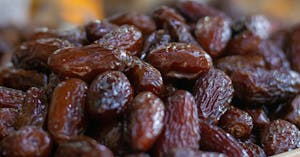
THE SOUR TASTE
This taste is also quite familiar. We often “pucker” when we encounter the sour taste. It immediately moistens the mouth and increases the flow of saliva. Sourness is found in grapefruit, lemon, lime and tamarind, tomatoes and pickled vegetables, and dairy foods such as feta cheese, sour cream and yogurt.
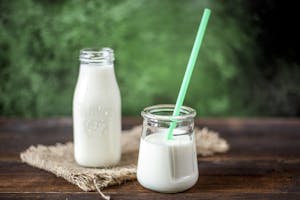
THE SALTY TASTE
This taste is almost singularly derived from salt, making it easy to identify in our diets. However, other sources of saltiness include celery and seaweed.

THE PUNGENT TASTE
This dry heat taste may be less familiar, although it can be found in many foods, including chilies, garlic, leeks, onions, mustard greens, radishes, turnips and raw spinach, buckwheat and spelt, and mustard seeds. Most herbs and spices are pungent, especially black pepper, cardamom, cayenne, cloves, ginger and paprika.
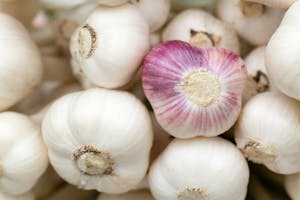
THE BITTER TASTE
The bitter taste is quite familiar as a taste that most people avoid. Good examples include leafy greens such as kale, collards, dandelion greens and eggplant. Sesame, coffee, and dark chocolate, as well as spices such as cumin, dill, fenugreek, saffron and turmeric are good sources of bitterness.

THE ASTRINGENT TASTE
This dry flavor immediately produces a dry, chalky sensation in the mouth. The astringent taste is frequently complimented by sweetness or sourness. Fruit, such as apples, green bananas, cranberries and pomegranate are astringent. So are vegetables like alfalfa sprouts, Brussels sprouts, raw broccoli and cabbage, as well as spices like basil, bay leaf, caraway, coriander, dill, fennel, marjoram, nutmeg, oregano, parsley, poppy seeds and rosemary.
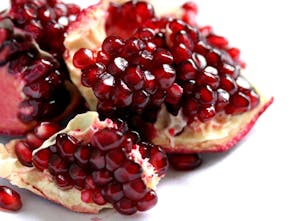
So, the next time you have a craving, analyze which taste was missing from your diet during the past 24 hours. Eat a food from that taste group and see how quickly your craving disappears. You'll be surprised how you can manage cravings by incorporating these six tastes into your daily meal plans.
Nutrition
All disease begins in the gut. - Hippocrates
The process of digestion and absorption is critical to health. We have to be conscientious about what we eat and how foods benefit us.
At the very simple level, the human body has to have a balanced pH (acid/base level) to function correctly. Research has proven that disease cannot survive in an alkaline state, yet it thrives in an acidic environment.
On the pH scale of 1 to 14, an acidic environment is less than 7.4. A basic or alkaline setting is greater than 7.4. The human body works best when it remains close to 7, which is neutral. You can find more information and pH values here.
Healthy gut flora, the complex community of microorganisms living in the digestive tract, has a balanced pH. Probiotics, which are typically associated with a healthy digestive system, may also help maintain this balance. These five foods help improve gut flora and balance the body's pH:
Wheatgrass
Wheatgrass is a good source of potassium, dietary fiber, vitamin A, vitamin C, vitamin E (alpha tocopherol), vitamin K, thiamin, riboflavin, niacin, vitamin B6, pantothenic acid, iron, zinc, copper, manganese and selenium. It's also a source of protein.
This food's high alkalinity helps balance your body's pH levels. Wheatgrass is a complete food that provides enzymes and all essential amino acids, as well as antioxidants that help repair damaged cells. Some other benefits may include:
- Naturally increasing and sustaining energy
- Detoxifying and cleansing your body
- Strengthening your immune system
The best way to consume wheatgrass is through freshly squeezed juice. If this isn't a viable option for you, the powdered form is a good alternative.
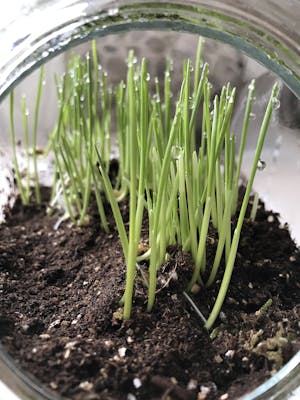
Kefir
Kefir is a unique cultured dairy product that is one of the most probiotic-rich foods on the planet. It has incredible medicinal benefits for the digestive system, such as:
- Boosting immunity
- Healing inflammatory bowel disease
- Building bone density
- Fighting allergies
- Improving lactose digestion
- Killing candida (harmful yeast)
- Supporting detoxification
The best kefir is home made, since you know the quality of the milk, the container and anything you add to each batch. If making at home isn't an option, plain greek kefir is a good alternative.
If you are lactose intolerant, you may make water kefir to gain many of the same benefits.

Kombucha
Kombucha describes a variety of fermented, lightly effervescent, sweetened black or green tea drinks that are commonly consumed for their health benefits. Kombucha is produced by naturally fermenting tea using a symbiotic colony of bacteria and yeast (SCOBY).
A probiotic beverage that aids digestion and gut health, kombucha provides numerous benefits, from fighting candida (harmful yeast) overgrowth to improving mental clarity and mood stability.
Kombucha is quite easy to brew at home. You can get a starter kit at most health food stores or from The Kombucha Shop.
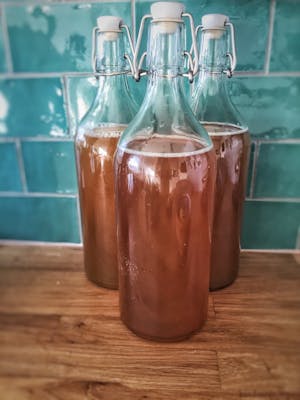
Yogurt
Yogurt is created through the bacterial fermentation of milk. The process involves adding healthy bacteria to milk in a controlled temperature environment.
Yogurt provides a dose of animal protein plus vitamins and nutrients such as calcium, vitamins B-2 and B-12, potassium and magnesium. It's an appropriate option for breakfast, snacks and other meals.
The best yogurt is homemade, since you know the quality of the milk, the container and anything you add to each batch. Most store-bought yogurt contains sugar and preservatives. I am happy to share my homemade starter and help you start making your own yogurt.
If making a batch at home isn't an option, plain Greek yogurt is a good alternative.
Tagged: vitamins, dairy, nutrition, health, probiotics

Sourdough
The bacteria in sourdough pre-digests the flour, releasing micronutrients. This process takes place during a long, slow fermentation, which also gives the loaf a superior taste and texture. Plus, sourdough bread takes longer to digest, helping you feel full after you eat it.
The best sourdough is the one that you bake at home. All you need are flour, water and salt. All of the unnatural ingredients included in commercially produced bread are eliminated. To get started, try this great homemade recipe that I've been using.
If you choose to buy your bread, find a local bakery and buy a fresh sourdough loaf made from whole wheat, rye or spelt.

Non Toxic Cookware
We spend so much time and effort into eating healthy, it is equally important to educate our selves in healthy cookware and bakeware.
The main issues with traditional cookware like non-stick and aluminum is that they can leach hormone disrupting chemicals and toxins into food…and choosing a non toxic cookware can be confusing. After much reading and trial and error, here is what I recommend.
Nonstick/ Teflon cookware: Get rid of it, non-stick cookware is made using a carcinogenic chemical called perfluorooctanoic acid (PFOA), which starts emitting toxic fumes that you inhale every time you cook with a non-stick pot or pan!
Cast Iron: I love the old fashioned cast iron pots and pans. It is durable, versatile and pretty easy to use, once you get a hang of seasoning it. Here is a website with great instructions: http://www.thekitchn.com/how-to-season-a-cast-iron-skillet-cleaning-lessons-from-the-kitchn-107614. If you are low in iron, cast iron is an excellent choice. If you don't want additional iron, enameled cast iron is another choice. My favorite brand for cast iron pans are Good Old Lodge and for enameled cast iron I like Le Crueset.
Stainless Steel: This is a good choice. My favorite stainless steel cookware is a rice cooker. It is pretty easy to use and cooks brown rice perfectly well. Stainless steel pots and pans can be used in so many different ways.
Bakeware: Finding the right bakeware is tricky. Cast iron, stainless steel and glassware require a lot more oil, and still stick. Aluminum bakeware gets chipped off pretty easy and then leaches into the food. By far the best bakeware is Demarle at Home. They make the commonly known Silpat and other Flexipans of silicone and woven glass. The silicone contributes the nonstick properties and the conductivity of the woven glass, an even cooking process. No additional spraying of oil or flouring of pans is necessary. The Flexipan conforms to European, French and US silicone regulations. It has been awarded the NSF certification for safety and quality design, Kosher and it is US FDA approved. The Flexipans and trays also carry a lifetime manufacturing defect warranty. You can get more information and purchase these pans at www.mydemarleathome.com/mara











